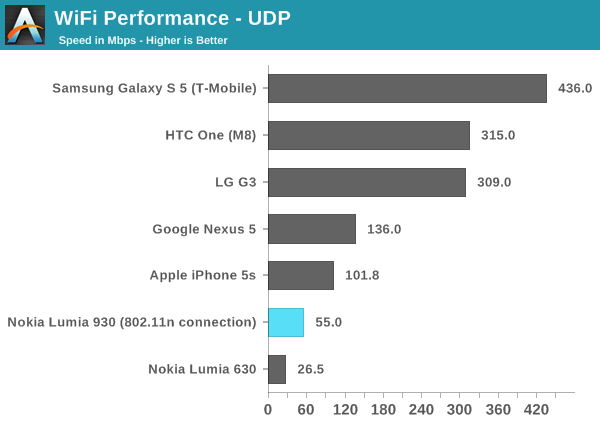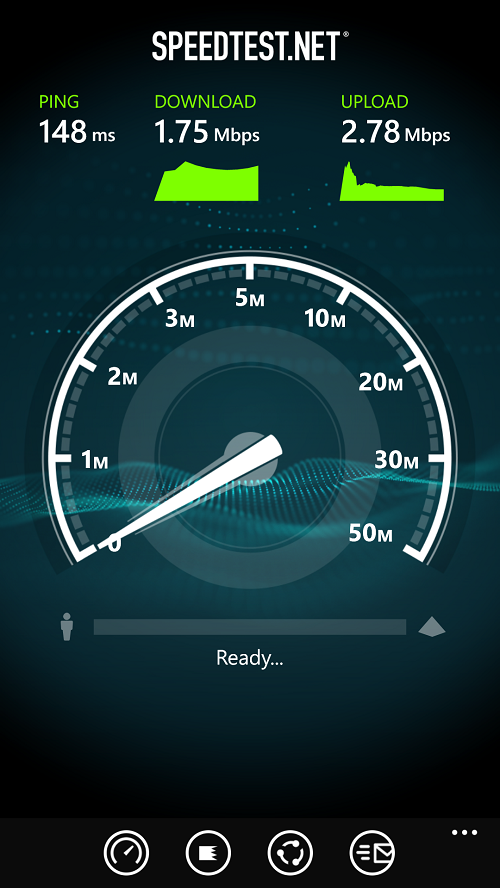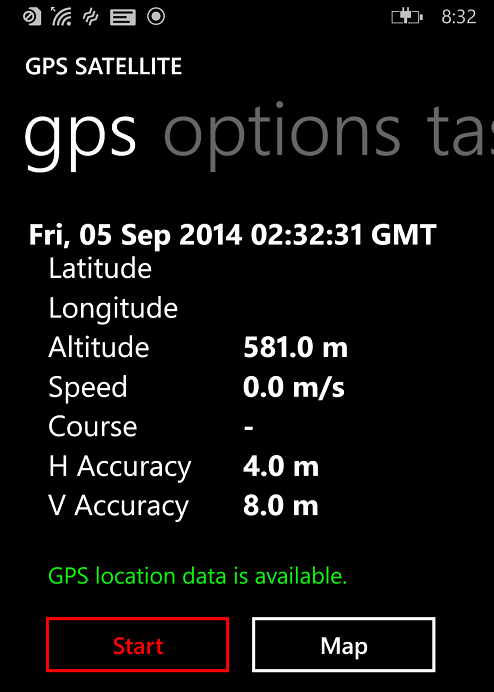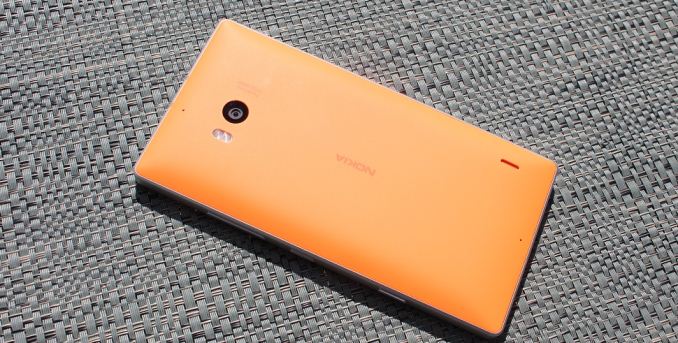Nokia Lumia 930 Review
by Brett Howse on September 8, 2014 3:00 PM EST- Posted in
- Smartphones
- Microsoft
- Nokia
- Mobile
- windows phone
- Lumia
Wi-Fi
The Snapdragon 800 SoC supports 802.11 a/b/g/n/ac wireless, and the Lumia 930 implements all of them, which means it supports 5 GHz as well as 2.4 GHz Wi-Fi. There is only single band Wi-Fi though, so on the typical N network you would be limited to a maximum connection speed of 150 Mbps. If you own an 802.11ac router, connection speeds will get bumped to the maximum of 433 Mbps.

I was able to achieve peak transfer rates of around 55 Mpbs with the Lumia 930 on a Wireless N router with just the 930 attached. Due to only having 802.11n available, the maximum transfer speed is going to be reduced compared to 802.11ac.
Cellular
Cellular connectivity on the Lumia 930 supports category 4 LTE for maximum download speeds of 150 Mbps, with 50 Mbps upload. LTE bands on the 930 that I was sampled were 1, 3, 7, 8, and 20, which prevented me from testing LTE at my location. DC-HSPA is also supported for up to 42.2 Mpbs downloads if available in your area.
Speedtest.net did not give me great numbers on the days I tested it, but that can be typical of HSPA depending on cell tower usage.
GNSS
Again, with the Qualcomm silicon at the heart of this device, we’re working with well known, and well tested parts such as the GNSS. The Lumia 930 supports Cellular and Wi-Fi assist and supports GPS, GLONASS, and BeiDou for location, and it locks quickly. Hopefully the days of poor location tracking are over.
Speaker
The 930 has just a single rear-facing speaker. Both volume and sound quality are surprisingly good with this speaker, but there is certainly no sense of stereo sound. For notifications, this speaker is adequate for the task but if you are going to watch a movie, you would be happier with a set of headphones.













115 Comments
View All Comments
pjcamp - Tuesday, September 9, 2014 - link
Not a dev. THE dev. Marcus Duarte himself claimed that users find two storage locations confusing.How we've muddled along with multiple storage locations on laptops all these years must confuse HIM to no end.
Besides this is Linux. It is possible to make a single file system spanning multiple devices. There's no reason Android couldn't clear up the "confusion" that way.
tuxRoller - Tuesday, September 9, 2014 - link
This ^I guess they've never heard of lvm/MD/btrfs.
Alexvrb - Tuesday, September 9, 2014 - link
That's not limited to Linux. I mean heck there's multiple approaches, some are completely software agnostic.Anyway, MS tried something like that with Windows Phone 7. It creates another problem when the user wants to REMOVE the memory card any time they want (users are stupid, this was a common complaint with WP7 I kid you not, result was WP8 separating the two again). WP 8.1 has a better middle-ground solution. Keep the spaces seperate but make better (and easier) use of the memory card.
BMNify - Monday, September 8, 2014 - link
Then get Lumia 1520 or 1320 or 630 or soon to be released Lumia 830 and 730, loads of options for MicroSD fanatics.jimbo2779 - Monday, September 8, 2014 - link
The issue is that this is meant to be the flagship phone at a reasonable size, the 1520 and 1320 are too big for the majority of users, the 830 is running a far inferior SoC, less RAM, poorer quality screen and camera, everything lower is in the same boat as the 830 or even worse so really the lack of SD card support here is it's main disappointment.I was looking forward to this phone so much only to find out it had no SD card support, any user of a Lumia (or other WP phone) with SD card support knows that it is so easy to use and allows for much more space than is available in a phone.
Would you rather have a phone with 32Gb or 96Gb? I know which I would prefer and I definitely would have bought a 930 outright to replace my 925 as this is an upgrade in every way but for some unknown reason they decided to make it the only phone in this years line-up without SD card support meaning it is a no go for me.
Reflex - Monday, September 8, 2014 - link
The question is what feature would you drop in order to gain that MicroSD slot? Because the 930/Icon is packed very tightly, it has everything that is in the 1520, yet in a full inch smaller package. Furthermore, it is barely larger overall than most 4.5" phones, so they really packed it tight.I am not willing to go with a larger phone. The features they did include are all very useful to me, I'd be pissed to lose, say, Qi charging, for a SD slot. I get that you want it all, but there are tradeoffs. Either you get the 930 with SD but without something else that takes up space, or you get it without SD support, or you get a larger phone that has all of it included (1520). The reason the 1520 exists is because there are some who are not willing to compromise. Quite frankly the 1520 is the phone you should be looking at, it was made with you in mind.
Also, the 520 has a SD slot not because its a high end feature but because it permits them to sell a phone with very little integrated storage, putting that part of the cost in the hands of the buyer.
Samus - Monday, September 8, 2014 - link
Most SD cards are slow, the controllers are slow, both add complexity and space to the PCB, most people rarely, if ever, use them, and most importantly, they drain the battery.If I were designing a small phone, I wouldn't put in external storage, either. Phablets and Tablets, sure...but with everything (especially WP8) becoming cloud-centric now, I don't see the need for physical media in a phone.
ummduh - Monday, September 8, 2014 - link
The cloud this, the cloud that, cloud, cloud, cloud cloud cloud.Do none of you people ever go outside the city you live in? End up in the mountains? The woods? A back country road that just happens to not have a signal?
I spend sometimes weeks on job sites out in the middle of nowhere with no signal. No wifi, either, since, ya know, it's a job site.
The cloud is 100% useless in those situations. Yea it's a neat toy, and can be handy when you never ever lose service. And you're willing to pay more and more for less and less data service.
Otherwise, you need storage on the device. 16GB, 32GB doesn't cut it. An endless supply is 64-128GB mSD cards, however, does. After apps are installed, I can only put a couple GB of music on my phone before it's filled. And then I get nagged to death by low storage warnings.
The cloud can go screw itself.
Reflex - Monday, September 8, 2014 - link
And in your situation that makes sense. However that is an edge case and the market really isn't, nor should it be, tailored to edge cases. Also, as someone who has compared coverage between carriers, I strongly suggest Verizon which tends to work just about everywhere, even in the backwoods, at least in the northern half of the country.ummduh - Monday, September 8, 2014 - link
So, I should pay extra amounts of money, every month, to stream the same data over and over to my phone, instead of carrying said data on my phone to begin with, and not keep incurring ever increasingly exorbitant monthly fees? What sense does that make?Pay to have the amount of data I'd need monthly (10GBish), over, and over, and over, and over.. etc. Or, $25 mSD?
It's not market tailoring, it's data fees extortion.